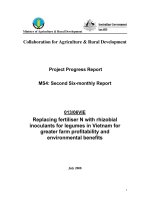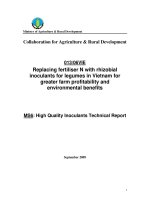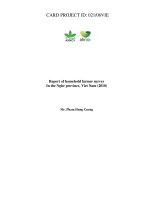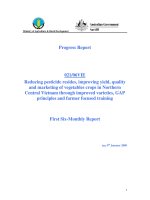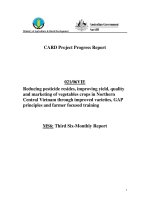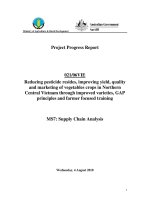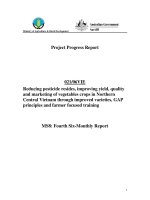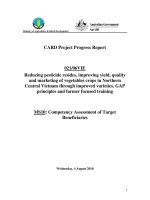Báo cáo khoa học nông nghiệp " Commercial and High Quality Cultivars of Root and Tuber Crops for Processing Purpose in the Northern and Central Vietnam " MS7 potx
Bạn đang xem bản rút gọn của tài liệu. Xem và tải ngay bản đầy đủ của tài liệu tại đây (298.75 KB, 14 trang )
Ministry of Agriculture & Rural Development
Collaboration for Agriculture & Rural Development
008/07VIE
Commercial and High Quality Cultivars of Root and Tuber Crops for
Processing Purpose in the Northern and Central Vietnam
Vietnamese Institution
Food Crops Research Institute, Ministry of
Agriculture and Rural Development
Vietnamese Project Team Leader
Assoc. Prof. Dr. Nguyen Van Tuat
Australian Institution
Faculty of Agriculture, Food and Natural
Resources, University of Sydney
Australian Project Team Leader
Professor Les Copeland
Outputs 3 and 4
MS7: Sweet potato processing
Preparation of animal feed from sweet potato leaves, vines and roots
Extraction of starch from sweet potato
May - 2010
1
I. Introduction
Sweet potato
1
(Ipomea batatas, a member of the Convolvulacae family), is grown in over 100
countries, mostly by small holder farmers. It has a high yield potential for biomass
production, is adapted to a wide range of habitats and soils, and ranks among the world’s top
ten food crops on production volume. Sweet potato is a versatile crop. The roots are eaten as
vegetables or are processed for diverse uses including making noodles and snack foods,
fermentation into alcoholic beverages, and production of starch. The roots are a good source
of edible energy in the form of starch, and also provide a source of dietary fibre from non-
starch polysaccharides. Sweet potato leaves are rich in vitamins A and C and have relatively
high protein content (25–30% of dry matter) compared to other leafy vegetables. The carotene
and anthocyanin pigments, which are responsible for the yellow, orange, red, or purple flesh
colours of the roots, are a source of natural pigments for the food industry. The roots, leaves
and vines are used for livestock feeding, as fresh or dried material, or after fermentation into
silage.
Fresh sweet potato roots normally contain between 20 and 50% dry matter, depending on
cultivar and developmental stage of the plant at harvest. Carbohydrates make up about 90% of
dry matter, most of which is starch. The sweetness is due to sugars, mainly maltose but also
sucrose, glucose and fructose, which can account for between 5 and 30% of the dry matter.
The other major components are non-starch polysaccharides (0.5-7.5%), protein (1-10%) and
lipids (1-2%). The composition of the roots varies depending on cultivar, environment for
crop growth, cultivation practices, postharvest storage, and influences nutritional, quality and
taste/texture properties.
Sweet potato roots deteriorate in processing and nutritional quality within about 2-3 weeks
after harvest, with loss of moisture and starch content and increase in sugars. Microbial
spoilage, particularly in damaged roots, and sprouting are other potential postharvest
problems. Processing is an important way of preserving the value of the large amount of
biomass produced by sweet potato plants that can not be used by farmers in the short time
before postharvest deterioration becomes significant.
The overall goals of the project are to improve yield and economic return from sweet potato
production in Thanh Hoa, Bac Giang and Quang Tri provinces of Vietnam by
- encouraging adoption of improved cultivars and planting materials
- providing farmers with greater options for value adding
- Enhancing skills of scientists, extension officers and farmers.
The specific objectives addressed in this section of the project are to demonstrate simple
proof-of-concept methods for
i. fermenting sweet potato leaves, vines and roots into a silage-type product for
animal feeding, and showing how the process may be adopted by small-holder
farmers
ii. Large scale extraction of starch from sweet potato roots.
1
Recommendedusagetodifferentiatesweetpotatofromthepotato(Solanumtuberosa),whichbelongstothe
Solanaceae.
2
Preparation of animal feed from sweet potato leaves, vines and roots
In this section of the project, a simple and efficient method was developed for processing
sweet potato vines, leaves and roots into livestock feed. The method was demonstrated to
local farmers in Bac Giang, Thanh Hoa and Quang Tri provinces.
The biological energy of the sweet potato biomass may be conserved, and the consumption
time for animal feed prolonged, by microbially fermenting the leaves, vine and roots under
anaerobic conditions. Anaerobic conditions have to be maintained subsequently during
storage to prevent spoilage of the material due to putrefaction. As described subsequently, salt
and a source of energy (cassava starch, rice bran or corn flour) are added to the sweet potato
biomass, as a starter for fermentation to provide the right conditions for rapid growth of the
appropriate microorganisms.
Research scope
- Produce livestock feed in Bac Giang, Thanh Hoa and Quang Tri
- Demonstrate the benefits to farmers from using the fermented vine-leaves and roots of
sweet potatoes.
- Solve technical challenges for fermentation processing and usage of the livestock feed.
II. Aims
The specific aims were to demonstrate technology that could be used to
- preserve sweet potato roots from microbial spoilage and vermin and thereby prolong the
shelf life of feed for pigs and cattle
- improve the digestibility and nutritional quality of the feed by stimulating the production
of organic acids such as lactic and acetic acids and amino acids from the biomass
- Improve the organizational efficiency of farms by saving energy and labour in preparing
feed for livestock and by processing the large volume of sweet potato biomass in a
timely manner after harvest and before the next crop.
- Increase economic efficiency of livestock growing by utilising all of the sweet potato
biomass, including roots unsuitable for human use because they are too small or large, or
damaged.
III. Methods
3.1. Locations
In Bac Giang province:
- Bich Son ward in Viet Yen town
- Ngoc Chau ward in Tan Yen town
- Mai Trung ward in Hiep Hoa town
In Thanh Hoa province:
- Nguyen Binh ward in Tinh Gia town
- Quang Luu in Quang Xuong town
3
- Dong Thanh ward in Dong Son town
In Quang Tri province
- Vinh Thai ward in Vinh Linh town
- Gio Hai ward in Gio Linh town
- Hai Quy ward in Hai Lang town
3.2 Ingredients for preparing livestock feed
- Sweet potato leaves, vines and roots, sliced and dried under the sun until tender.
- Dried rice bran or corn bran or corn flour.
- Salt.
3.3 Technology transfer methods
- Train and transfer to farmers the techniques to use vine-leaves and roots of sweet potatoes
- Design experiments to assess the processing by fermentation of the sweet potato biomass
in 15 households in the 3 towns of each province in order to recommend these processes
to other households.
- Prepare different ingredients for fermentation processes of the sweet potato biomass:
o For the sweet potato vine and leaves
90% wilted vine-leaves + 10% rice bran + 0.5% salt
97.5% wilted vine-leaves + 2.5% sugar cane molasses + 0.5% salt
94% fresh vine-leaves + 6% corn flour + 0.5% salt
o For the sweet potato roots
10% root + 89.5% fresh vine-leaves + 0.5% salt
25% root + 75% fresh vine-leaves + 0.5% salt
50% root + 50% fresh vine-leaves + 0.5% salt
(Note: the starch in the sweet potato roots serves as the energy source and
hence sugar, molasses, corn starch, etc., do not have to be added as well)
- Instruct the households on the techniques for fermenting sweet potato biomass. The
fermentation period to achieve a stable pH was about 2 weeks for sliced-vine-leaves and 3
weeks for sliced-roots.
- Show farmers how to preserve the fermented products; if the products are kept in
anaerobic conditions created by the air-tight enclosure in plastic, the shelf-life will be
extended for up to 6 months without reducing safety and nutrition.
- Guide the farmers how to use and mix the fermented feeds with the other materials for
pigs with different weight. Pigs of 2.5 months or 18 to 20 kg are able to eat the fermented
feed. In the first two days, the pigs should consume 2 meals per day with the mixture of
the fermented mash and bran per day. Then they can be fed 3 meals per day (morning,
noon and evening).
3.4 Participants
- Food Crops Research Institute (FCRI): Nguyen Van Tuat, Truong Cong Tuyen, Nguyen
Dat Thoai, Truong Thi Thuy, Nguyen Phan Anh, Tran Quoc Anh, Do Thi Lieu, and
Nguyen Thi Hoai
4
- The University of Sydney: Les Copeland, Peter Sharp, Richard Trethowan
IV. Research results
4.1. Livestock feed production in Bac Giang province
4.1.1. Fermentation of vine-leaves
After about 60 days of growth sweet potato plants are pruned to remove roughly half of the
foliage. At this stage the storage roots have not developed but if the vines and leaves are cut
properly, the subsequent development of the storage roots will be enhanced. The fermentation
process and the ingredients used for vines and leaves were as recommended by the
International Potato Centre (Centro Internacional de la Papa-CIP). The quality of the
fermented sweet potato product was evaluated by its visual appearance, consistency of
texture, the presence of a sweetish, slightly acidic aroma, the absence of foul odours, and its
appeal to livestock.
After growing 120 days, farmers can harvest sweet potato roots and collect vine-leaves. Roots
that are too small or too big roots and damaged roots can be mixed with the vines and leaves
for fermentation.
It was found that the fermentation process for ingredients of the sliced fresh vine-leaves and
sliced roots were convenient, simple and gave a good quality of fermented product. Utilisation
of the sweet potato roots could reduce the expenditure for feeding raw materials. Good results
were obtained when the experiments were carried out in the nine locations in Bac Giang,
Thanh Hoa and Quang Tri provinces.
The fermentation products from the different ingredients for sweet potato vine-leaves were
evaluated in Bac Giang as shown in the Table 1.
Table 1. Evaluation of fermented products of sweet potato vine-leaves in Bac Giang,
years 2008-2009
Locations Bich Son-Viet Yen Ngoc Chau-Tan Yen Mai Trung-Hiep Hoa
Ingredients (1-5) (1-5) (1-5)
CT 1
5 5 5 5 5 4 5 5 4 5 5 3 4 4 5
CT 2
5 4 4 5 4 4 4 5 5 5 4 3 5 4 5
CT 3
5 5 5 5 4 5 5 5 5 5 5 3 4 4 4
Note:
Score range 1-5: 1= very bad; 2 = bad, 3 = medium; 4= good; 5 = very good.
CT1: 90% wilted vine-leaves + 10% rice bran + 0.5% salt
CT2: 97.5% wilted vine-leaves + 2.5% cane molasses + 0.5% salt
CT3: 94% fresh vine-leaves + 6% corn flour + 0.5% salt
Table 1 showed that the fermented product had either good or very good quality with most
scores of 4 and 5. All of the households carried out the experiments properly by following the
instructions under the supervision of the FCRI staff.
5
In the wards in Viet Yen, Tan Yen and Hiep Hoa, the farmers became familiar with the
fermentation technology of sweet potato vine-leaves and obtained finished products with good
quality.
The comprehensively described technology processes enabled farmers to apply it easily so
that the quality of the fermentation products could not be differentiated after using the various
ingredient combinations with sweet potato vine-leaves.
This means the method is flexible enough for farmers to use the available ingredient materials
they have for fermentation of sweet potato vine-leaves depending on the economic and market
conditions at the time.
4.1.2. Fermentation of sweet potato roots
Table 2. Evaluation of fermented products of sweet potato roots in Bac Giang, years
2008 – 2009
Locations Bich Son-Viet Yen Ngoc Chau-Tan Yen Mai Trung-Hiep Hoa
Ingredients (1-5) (1-5) (1-5)
CT 1
5 5 5 5 5 5 4 5 5 3 5 3 5 5 5
CT 2
5 5 5 5 5 5 4 5 5 3 5 3 5 5 5
CT 3
5 5 5 5 5 5 4 5 5 3 5 3 5 5 5
Note:
Score range 1-5: 1= very bad; 2 = bad, 3 = medium; 4= good; 5 = very good.
CT1: 10% root + 89.5% fresh vine-leaves + 0.5% salt
CT2: 25% root + 75% fresh vine-leaves + 0.5% salt
CT3: 50% root + 50% fresh vine-leaves + 0.5% salt
As shown in Table 3, the households at Bich Son ward in Viet Yen town produced the best
quality of fermented products in the 15 households. The lower scores of 3 in some of the trials
in Ngoc Chau-Tan Ten and Mai Trung-Hiep Hoa were due to damage to the bags from rats
and other rodents, so that some of the fermented material was exposed to air. The quality of
the fermented products in these was decreased due to spoilage by bacteria and mould growing
in the aerobic environment.
4.2. Livestock feed production in Thanh Hoa province
4.2.1. Fermentation of vine-leaves
The fermented products of vine-leaves in the three towns of Thanh Hoa were evaluated and
shown in the table 3 below.
6
Table 3. Evaluation of fermented products of sweet potato vine-leaves in Thanh Hoa,
years 2008 – 2009
Locations Dong Thanh-Dong
Son
Quang Luu-Quang
Xuong
Nguyen Binh-Tinh Gia
Ingredients (1-5) (1-5) (1-5)
CT 1
3 4 5 5 5 4 4 5 4 5 5 5 5 5 5
CT 2
3 4 4 5 4 4 4 5 5 5 5 5 5 5 5
CT 3
3 4 5 5 4 4 4 5 5 5 5 5 5 5 5
Note:
Score range 1-5: 1= very bad; 2 = bad, 3 = medium; 4= good; 5 = very good.
CT1: 90% wilted vine-leaves + 10% rice bran + 0.5% salt
CT2: 97.5% wilted vine-leaves + 2.5% cane molasses + 0.5% salt
CT3: 94% fresh vine-leaves + 6% corn flour + 0.5% salt
- The households in Nguyen Binh-Tinh Gia produced the best fermented feed quality with
all scores of 5. The quality was scored from 4 to 5 in Quang Luu and it was 3 in one
household at Dong Thanh-Dong Son.
- In all locations, the households followed the same processing protocol for fermentation
experiments and therefore almost all of the products had the same good quality. The only
household with a score of 3 was in Dong Thanh-Dong Son, which was due to a leaking
plastic bag.
- Since the ingredients for fermentation were simple and the processing technologies were
straight-forward, the farmers were able to produce livestock feeds with uniformly good
quality.
4.2.2. Fermentation of sweet potato roots
The fermentation trials of roots and vine-leaves gave many benefits because the farmers in
Thanh Hoa harvested a large number of sweet potato roots in a short time. The utilization of
roots was able to save input costs for farmers as an alternative to purchasing rice bran, corn
flour and sugar cane molasses as a carbohydrate source to promote the growth of the right
bacteria for good fermentation. In addition, the trails demonstrated how the farmers could
save time and money by not having to buy, transport and store rice bran, corn bran or corn
flour for livestock feed preparation. Moreover, consumption of unsalable sweet potato roots
for the animal feed could clear up the field efficiently and quickly. The small roots and
residual vine-leaves were combined to produce fermented livestock feed as shown in the
Table 4.
Table 4. Evaluation of fermentation products of sweet potato roots in Thanh Hoa, 2008-09
Locations Dong Thanh-Dong
Son
Quang Luu-Quang
Xuong
Nguyen Binh-Tinh Gia
Ingredients
(1-5) (1-5) (1-5)
CT 1
5 5 5 5 5 5 5 5 5 4 5 5 5 5 5
CT 2
5 5 5 5 5 5 5 5 5 4 5 5 5 5 5
CT 3
5 5 5 5 5 5 5 5 5 4 5 5 5 5 5
7
Notes:
Score range 1-5: 1= very bad; 2 = bad, 3 = medium; 4= good; 5 = very good.
CT1: 10% root + 89.5% fresh vine-leaves + 0.5% salt
CT2: 25% root + 75% fresh vine-leaves + 0.5% salt
CT3: 50% root + 50% fresh vine-leaves + 0.5% salt
- All of the households in Thanh Hoa successfully produced of fermented feed products of
very good quality.
- The farmers growing sweet potato as part of Project AUSAID CARD 008/07VIE was
very happy to apply the fermentation technology for livestock feeds. Beside the
households that participated these experiments, many others outside the project applied
the root fermentation technique for animal feed.
- Based on the fermentation technology for sweet potato root with vine-leaves, the farmers
in the project will try to use sweet potato roots with vine-leaves of other plants such as pea
nut and cassava. That is a good approach to utilize the biological yield for livestock
feeding.
4.3. Livestock feed production in Quang Tri province
4.3.1. Fermentation of sweet potato vine-leaves
Similar to Bac Giang and Thanh Hoa, the farmers in Quang Tri have a traditional method to
process the livestock feed by cutting and drying the sweet potato vine-leaves. The dried vine-
leaves can be preserved and used for feeding over a long time. However, the fermented feed
has microbial metabolites (lactic acid, acetic acid, etc.) and biomass (amino acid, protein, etc.)
providing good benefits for nutrition and digestion.
In addition, the farmers in Quang Tri found that the ingredients were simple and the
processing process was comprehensively described to be applied. Therefore the households of
the project in Quang Tri joined enthusiastically the fermentation technology of sweet potato
vine-leaves for livestock feed. The quality of the fermented products was evaluated and
shown in the table 5.
Table 5. Evaluation of fermented products of sweet potato vine-leaves in Quang Tri,
2008 – 2009
Locations Vinh Thai-Vinh Linh Gio Hai-Gio Linh Hai Quy-Hai Lang
Ingredients
(1-5) (1-5) (1-5)
CT 1
5 4 5 5 4 4 4 5 4 5 5 5 5 5 5
CT 2
5 4 4 5 4 4 4 5 4 5 5 5 5 5 5
CT 3
5 4 5 5 4 4 4 5 4 5 5 5 5 5 5
Note:
Score range 1-5: 1= very bad; 2 = bad, 3 = medium; 4= good; 5 = very good.
CT1: 90% wilted vine-leaves + 10% rice bran + 0.5% salt
CT2: 97.5% wilted vine-leaves + 2.5% cane molasses + 0.5% salt
CT3: 94% fresh vine-leaves + 6% corn flour + 0.5% salt
Table 5 shows that the quality of fermented products from vine-leave was not significantly
different.
8
- The farmers in Quang Tri were very happy because they could easily source the raw
materials and quickly learn the fermentation technology in order to produce good feed for
rapid livestock growing.
4.3.2 Fermentation of sweet potato roots
The farmers accepted the fermentation models of roots because the harvested yield left a high
ratio of small roots. The models in Quang Tri province were evaluated and shown in the table
6 below.
Table 6. Evaluation of fermentation products sweet potato roots in Quang Tri, years
2008 – 2009
Locations Vinh Thai-Vinh Linh Gio Hai-Gio Linh Hai Quy-Hai Lang
Ingredients
(1-5) (1-5) (1-5)
CT 1
5 5 5 5 5 5 5 5 5 5 5 5 5 5 5
CT 2 5 5 5 5 5 5 5 5 5 5 5 5 5 5 5
CT 3
5 5 5 5 5 5 5 5 5 5 5 5 5 5 5
Notes:
Score range 1-5: 1= very bad; 2 = bad, 3 = medium; 4= good; 5 = very good.
CT1: 10% root + 89.5% fresh vine-leaves + 0.5% salt
CT2: 25% root + 75% fresh vine-leaves + 0.5% salt
CT3: 50% root + 50% fresh vine-leaves + 0.5% salt
The fermentation processes of sweet potato roots in the three town of Quang Tri were
extremely successful with the best quality, with all scores at 5.
The combination of sweet potato roots and vine-leaves was useful and applicable because it
brought farmers convenience and economic efficiency for livestock feeding.
V. Conclusion and general comments
5.1. Economic efficiency of using fermented vine-leaves and roots
The use of fermented vine-leaves and roots provided economic benefits to farmers:
- Utilisation of the whole biomass yield of sweet potato
- Significant reduction in expenditure on livestock feed livestock to increase the farmer income. At
the CARD Project Forum held on 6 April 2010, representatives from the provinces concerned
spoke of the benefits of fermenting the sweet potato foliage as a value adding process, indicating
that it could reduce the amount of the usual feed used by up to 30-50%
- Help pigs and cattle gain more weight due to the nutritional benefits of the fermented feed, such as
high digestibility (short chain carbohydrates and organic acids) and high protein content (amino
acid and biomass from microbial cells).
- The fermentation processes are applicable at household scale because of simple ingredients and
tools, and comprehensively-described procedures
- Using the fermented feeds is convenient because of a long shelf life and its ready-to-feed nature
for livestock.
5.2. Technical challenges for processing and use of fermented feed
9
- The ingredients need to be mixed well to achieve homogenous distribution of moisture and
nutrients for good microbial growth
- The bags need to be packed tightly to minimize the air to promote microbial growth under
anaerobic conditions
- Complete consumption of one bag at a time, before opening a new one. The bags should be
repacked tightly after withdrawing feed, and inspected periodically to check for spoilage.
VI. Appendixes
6.1 Fermentation process of sweet potato vine-leaves
Step 1: Raw material preparation
- Cut vine-leaves into pieces of 0.2 to 0.5cm using a kitchen knife or a special cutting tool
- Wilt under the sun immediately after cutting to minimize the nutrition loss due to respiration by
the fresh vine-leaves.
Step 2. Ingredients preparation
- After the vine-leaves are wilted, prepare the additives (rice bran, corn bran, corn flour, cassava
starch and salt) as calculated and weighed according to the formula.
Step 3. Mixing
- Mix rice bran, corn bran, and corn flour or cassava starch with salt to make a homogeneous
mixture.
- Mix the additive mixture thoroughly with the cut and wilted vine-leaves
Step 4. Packing
- Pack the mixture tightly into a polyethylene (PE) bag enclosed in a woven polypropylene (WPP)
bag. The PE layer has low oxygen permeability to create the anaerobic conditions for the growth
of fermentative bacteria. The WPP layer keeps the PE layer from breaking and tearing when the
mixture is pressed tightly, transported and stored.
Step 5. Storage
- Keep the fermented feed in a dry, cool place to prevent damage from insects and rodents. If the
bag is damaged, the feed will have a bad odour due to spoilage by bacteria and mould. The feed
can be used after 2 weeks of fermentation, and has a shelf life of about 6 months under good
storage conditions.
6.2. Fermentation process of sweet potato roots
Step 1. Raw material preparation
At harvest time in the spring and winter season, growers have fresh vine-leaves and roots to prepare
the livestock feed.
Cut or slice roots to the same size of the cereal grain by hand or by the cutter. If using the cutter, the
roots have to be pre-cut to the size fitted to the cutter intake.
Step 2. Additive preparation
10
The producers will choose a suitable ingredient depending on many factors such as the numbers of
pigs, the sweet potato crop season, the quality and quantity of sweet potato roots and so on. It is very
important for them to utilize the available materials and correct additives to ferment the feed for pigs
or cattle.
Step 3. Mixing
Mix the cut vine-leaves and roots well with salt. The small reject size roots are used to replace rice
bran, broken rice, corn flour in order to reduce the input cost for purchase of additives.
Step 4. Packing
It is the same with the packing stage for fermentation process of vine-leaves.
Step 5. Storage
The livestock feeds fermented from sweet potato roots are available to use after 3 weeks of
fermentation. Their shelf life will also be 6 months if stored in good conditions (dry and cool place).
6.3. Summary of fermentation process for sweet potato vine-leaves and roots
Steps Vine-leaves Roots
1 Cut and wilt vine-leaves Cut and slice fresh root
2 Weigh the wilted vine-leaves Weigh the fresh cut roots
3 Weigh additives: rice bran, or corn flour or
cassava starch with salt
Weigh additives: vine-leaves and salt
4 Mix additives well Mix additives well
5 Mix additives with the wilted cut well Mix additives with the wilted cut well
6 - Packing
- Stuffing
- Tightening
- Packing
- Stuffing
- Tightening
7 Record the time of fermentation, storage and
preservation
Record the time of fermentation, storage and
preservation
8 - Use after 2 week fermentation
- Tighten the bag after taking the feed
- Use after 3 week fermentation
- Tighten the bag after taking the feed
11
Fermentation model for livestock feed
Cutting sweet potato roots Mixing additives with the cut vine-leaves
Packing and stuffing The products after 3 weeks fermentation
12
Extraction of starch from of sweet potato roots
I. Introduction
Starch is the main storage carbohydrate of plants and a biopolymer of considerable significance for
humans. Starch is deposited in plant tissues as insoluble, semi-crystalline granules, which are made up
of two polymers of glucose: amylose, which is essentially unbranched, and the highly branched
amylopectin. Starch granules vary considerably, between and within plant species, with regard to size,
shape, amylose and amyl pectin content and functional properties relevant to food processing and
human nutrition. Starch is a macro-constituent of many foods and the main source of energy in the
human diet. How we digest starch has important health implications. Diets rich in rapidly-digesting are
associated with increased risks factors for obesity and diet-related diseases such as Type II diabetes,
cardiovascular disease and certain forms of cancer. In contrast, starch that is digested slowly and
starch that passes largely undigested into the lower gut (resistant starch) have health benefits. Starch is
also extracted industrially in large quantities for use in manufactured foods, pharmaceuticals and non-
edible products. Worldwide, 60 million tonnes/yr of starch are extracted from wheat, corn, potato, rice,
cassava, sweet potato, depending on local agriculture.
The main source of starch for industry in Vietnam is cassava roots. Most of the industrial starch is
used for food processing, as a substrate for microbial fermentation (mainly for production of
monosodium glutamate), manufacture of textiles, paper and other products. Production of cassava in
Vietnam increased from about 2 million tonnes per year prior to 2000 to 7.98 million tonnes in 2007,
largely as a result of varietal improvements. Cassava is now an important source of cash income to
small farmers. The area under cassava production is about 500,000 ha/year, with a crop yield of 16
t/ha, double that achieved in 2000. The increase in cassava production for starch manufacture led to a
big increase in processing capacity. There were no medium- or large-scale cassava starch factories in
Vietnam in 1990, whereas in 2007, there were 60 cassava processing factories with total processing
capacity of 3.2 - 4.8 million tonnes of fresh roots annually. In comparison, production of sweet potato
roots in Vietnam has for many years been between about 1.5 and 2 million tonnes per year. The area
under sweet potato production is about 200,000 ha/year, with a yield of about 8 t/ha compared to the
global average of 12-15 t/ha.
Sweet potato and cassava roots have similar dry matter content. Cassava roots have lower content of
reducing sugars, whereas sweet potato offers the benefit of more nutritious foliage than cassava and
environmental benefits, both in the growth of the crop and a cleaner starch extraction process.
Processing facilities for starch production from cassava should be suitable for use with sweet potato.
Sweet potato starch granules are larger and have higher AM content than cassava starch granules,
which may provide different functional properties suited to certain end uses, although for most
purposes sweet potato and cassava starches are likely to be comparable.
II. Isolation of starch from sweet potato
One of the objectives of this project was to demonstrate that high quality starch can be isolated from
sweet potato roots on a large scale using a simple procedure. The method used was adapted from a
protocol from the Postharvest Institute of MARD.
Freshly harvested sweet potatoes (100 kg) were washed in a stream of water, and passed twice through
a commercial kitchen blender. The blended mixture was placed in a coarse cloth bag inside a domestic
13
washing machine, which was used in the spin cycle as a simple centrifuge to separate the starch from
the fibrous root material. The starch was released in a water suspension, which was collected in a large
plastic tub and allowed to settle for 3 to 4 hours. After settling, the supernatant was decanted from the
sediment starch. The starch was washed by resuspending and sedimentation, first with water (2-3
times), then successively with dilute solutions of potassium permanganate, sodium bisulphate, bleach,
and finally again extensively with water. The washing treatments removed the colour, producing a
bright, white starch. The washed starch was dried firstly in air and then in an oven at 50-60
o
C.
The recovery of starch was 12-15 kg, which is an estimated yield of about 55-70%, based on
assumptions of 30% dry matter content of the sweet potato, of which 80% was starch. The extracted
starch was subjected to laboratory analysis at FCRI using Megazyme (International) analysis kits
(www.megazyme.com
) and shown to be free of α-amylase activity and to have low reducing sugar
content. These measurements mean that ….
III. Conclusion
This pilot scale-experiment conducted at FCRI demonstrates that high quality starch can be extracted
simply and in good yield from sweet potato roots using a simple protocol and equipment.
Equipment at FCRI used for washing, centrifuging and drying steps in
starch extraction from sweetpotato roots
